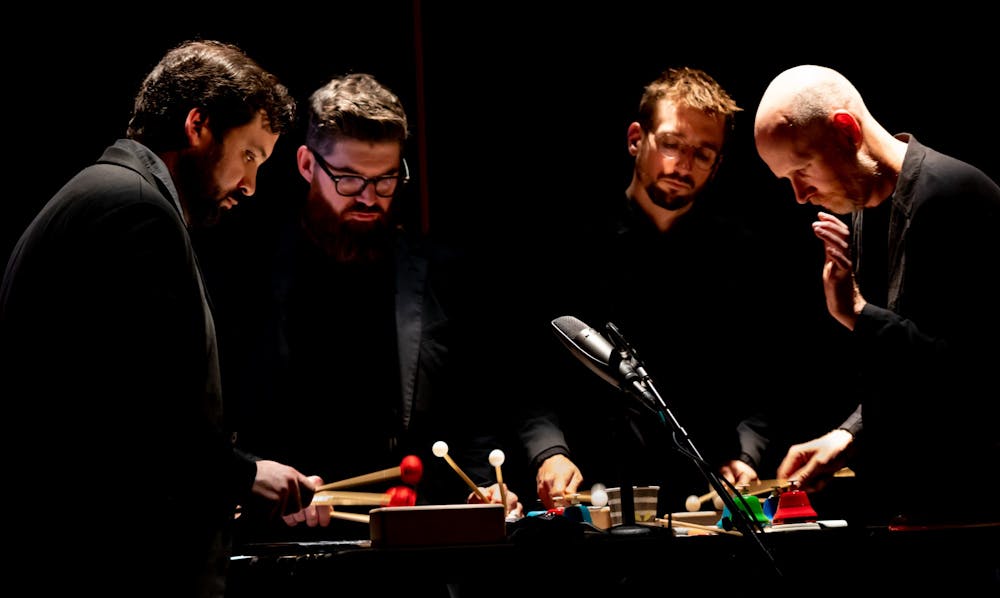Sō is back! On Sept. 18, the percussion quartet and Edward T. Cone Performers-in-Residence at Princeton University performed their season opener in Princeton with a program featuring works from the late 20th and 21st centuries. From cymbals to voice to custom-made string instruments, the repertoire consisted of a diverse range of instrumentation that explored various textural sounds and experimental tones.
The concert opened with Movement I of Julia Wolfe’s “Dark Full Ride,” a quartet for four drum sets. The first movement, however, consists of nearly eight minutes of music solely written for hi-hat and ride cymbals. When composing the piece, Wolfe described her fascination with exploring “the enormous range of shimmering colours” produced by the cymbals.
In more conventional orchestral pieces, cymbals are usually used in sustained rolls to anticipate a climax or are struck to add rhythmic emphasis. Despite typically being confined to a background role, Wolfe’s instrumentation for just hi-hat and ride cymbals allows listeners to hear the wide range of sounds they produce. For example, an open hi-hat rustles and rings, whereas a tightly-closed hi-hat is more muted and articulated. Wolfe experiments with these opposing timbres to make the music feel unrestrained or introverted, respectively. Moreover, the ride cymbals, being much larger than a hi-hat, possess a darker tone, which Wolfe uses to add depth and richness to the texture of the piece. Being metal, the cymbals inevitably sound bright overall; however, it is through Wolfe’s exploration of the subtle differences between playing methods that creates a diverse variety of shimmering colors.
The piece begins with constant sixteenth notes, played on the edge of the hi-hat. This metronomic rhythm persists throughout the entire duration of the movement. The music then thickens with sporadic, dynamic swells and punchy, accented rhythms in between. As the swells become more frequent, one might expect the texture to continue to broaden — it is here that Wolfe delivers the unexpected: Instead, the sixteenth notes suddenly reduce to a tinnier sound, played on the bell of the cymbals.
Wolfe doesn’t just play around with the contact point of the cymbal — she also explores different sounds created by the opening and closing of the hi-hat. In softer sections, the hi-hat is completely closed, limiting the resonance of the cymbals to produce a drier sound. When building towards the climactic end of the movement, the hi-hat is completely open, creating tension and sustain.
The second piece on the program, “Vodalities: Paradigms of Consciousness for the Human Voice,” by Dominic Shodekeh Talifero, took experimenting with diverse textures to another level. This time, instead of playing with cymbals, Sō explored something much more intimate: the voice. Consisting of three movements, this piece explored three vocal modalities: breath art, vocal percussion, and beatboxing.
Here, Talifero recognised Sō’s educational efforts in experimenting with new sounds by describing how Sō learned how to “transcribe the pieces from a hip-hop-based oral tradition” and “figure out which physical, percussion-based instruments and which members … would be best suited to play each element.”
In contrast, the piece “Extremes” by Jason Treuting allowed Sō Percussion to demonstrate a skillful combination of exciting rhythms and higher-pitched metal tubes. Introduced with a deep bass drum paired with higher-pitched clanking metal tubes, the piece employed a unique juxtaposition of contrasting rhythms and metallic sounds. Filled with mesmerizing, complex polyrhythms, the piece demonstrates the wide range of rhythms, performers, and percussion sounds that can be innovatively combined into an auditory masterpiece. The audience is enveloped in an unpredictable world of subtle rhythms that blend and meld together to create a culminating harmony of unique percussive sounds.
Pauline Oliveros’s “Rolling Meditation,“ the fourth piece of the night, brought yet another unique auditory experience. Beginning with solemn, meditative sixteenth notes, each instrument slowly joined into a culminating unison. “Rolling Meditation” features several unique percussion instruments, including a majestic gong and singing bowls. As the underlying rumbling ebbed and flowed, various percussive instruments overlaid bright, seemingly idiosyncratic noises. Sitting in the audience, I felt inundated in a wave of sounds layered upon each other. Fitting to its name, I felt that the calm, deep serenity created by the repetitive rhythms and low rumbling was a perfect scene for meditation. As the piece approached the end, only the sounds of a single singing bowl, paired with a bird-like instrument, rang out in the theatre.
The concert closed with a Sō Percussion staple — Bryce Dessner’s “Music for Wood and Strings.” This piece features custom-made, dulcimer-like instruments that combine electric guitar and percussion and that can be bowed or struck with mallets. The piece opens with a hypnotic, atmospheric texture, courtesy of the bowed strings. The rhythm then slightly picks up speed as players begin to lightly tap the strings. Personally, this is my favorite section of the piece — the guitar-like sound produced by the dulcimer alongside the relaxed groove is reminiscent of the soundtrack in a coming-of-age film.
In line with the rest of the program, this music also explores a wide variety of textures, ranging from the tinny buzzing of tremolos to the clean strikes of woodblock. Sō Percussion also experiments with the different striking positions and methods on the string. For example, in some sections, the string appears to be muted by the hand to create sound, while in others, the string seems to be struck further away from the center of the instrument to create more sustain.
Although this concert featured a variety of textures that were explored individually, as a listener, I found that the most exciting parts happened when these different sounds were played together. In fact, it is in these sections that Sō’s understanding of voicing and phrasing truly shines. Whether it’s using the dry, driving sixteenth notes to highlight the crash of open hi-hat accents, or using the crisp sound of woodblocks as a pop of color amongst the atmospheric strings, Sō doesn’t just investigate new sounds — it uses them to tell a story.

Sophia Zheng is a Staff Writer for The Prospect who often covers topics related to art, music, culture, and society. She can be reached at syzheng@princeton.edu.
Kerrie Liang is a Contributing Writer for The Prospect at the ’Prince.’ She can be reached at kerrie.liang@princeton.edu, or on Instagram at @kerrie.liang.








